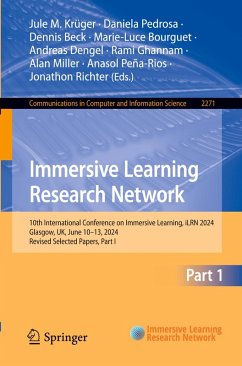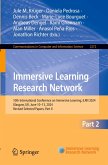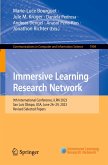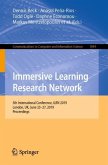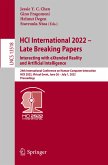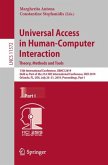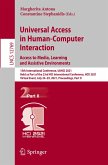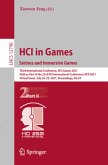Immersive Learning Research Network
10th International Conference on Immersive Learning, iLRN 2024, Glasgow, UK, June 10-13, 2024, Revised Selected Papers, Part I
Herausgegeben:Krüger, Jule M.; Pedrosa, Daniela; Beck, Dennis; Bourguet, Marie-Luce; Dengel, Andreas; Ghannam, Rami; Miller, Alan; Peña-Rios, Anasol; Richter, Jonathon
Immersive Learning Research Network
10th International Conference on Immersive Learning, iLRN 2024, Glasgow, UK, June 10-13, 2024, Revised Selected Papers, Part I
Herausgegeben:Krüger, Jule M.; Pedrosa, Daniela; Beck, Dennis; Bourguet, Marie-Luce; Dengel, Andreas; Ghannam, Rami; Miller, Alan; Peña-Rios, Anasol; Richter, Jonathon
- Broschiertes Buch
- Merkliste
- Auf die Merkliste
- Bewerten Bewerten
- Teilen
- Produkt teilen
- Produkterinnerung
- Produkterinnerung
This book constitutes the proceedings of the10th International Conference on Immersive Learning, iLRN 2024, held in Glasgow, UK during June 10-13, 2024.
The 30 full papers and 13 short papers presented in this volume were carefully reviewed and selected from 144 submissions. They were categorized under the topical section as follows:
Part I:
Foundations in Immersive Learning Research and Theory; Assessment and Evaluation (A&E); Galleries, Libraries, Archives and Museums (GLAM); Inclusion, Diversity, Equity, Access, and Social Justice (IDEAS); STEM Education (STEM); Medical &…mehr
Andere Kunden interessierten sich auch für
![Immersive Learning Research Network Immersive Learning Research Network]() Immersive Learning Research Network46,99 €
Immersive Learning Research Network46,99 €![Immersive Learning Research Network Immersive Learning Research Network]() Immersive Learning Research Network75,99 €
Immersive Learning Research Network75,99 €![Immersive Learning Research Network Immersive Learning Research Network]() Immersive Learning Research Network38,99 €
Immersive Learning Research Network38,99 €![HCI International 2022 ¿ Late Breaking Papers: Interacting with eXtended Reality and Artificial Intelligence HCI International 2022 ¿ Late Breaking Papers: Interacting with eXtended Reality and Artificial Intelligence]() HCI International 2022 ¿ Late Breaking Papers: Interacting with eXtended Reality and Artificial Intelligence64,99 €
HCI International 2022 ¿ Late Breaking Papers: Interacting with eXtended Reality and Artificial Intelligence64,99 €![Universal Access in Human-Computer Interaction. Theory, Methods and Tools Universal Access in Human-Computer Interaction. Theory, Methods and Tools]() Universal Access in Human-Computer Interaction. Theory, Methods and Tools68,99 €
Universal Access in Human-Computer Interaction. Theory, Methods and Tools68,99 €![Universal Access in Human-Computer Interaction. Access to Media, Learning and Assistive Environments Universal Access in Human-Computer Interaction. Access to Media, Learning and Assistive Environments]() Universal Access in Human-Computer Interaction. Access to Media, Learning and Assistive Environments38,99 €
Universal Access in Human-Computer Interaction. Access to Media, Learning and Assistive Environments38,99 €![HCI in Games: Serious and Immersive Games HCI in Games: Serious and Immersive Games]() HCI in Games: Serious and Immersive Games38,99 €
HCI in Games: Serious and Immersive Games38,99 €-
-
-
This book constitutes the proceedings of the10th International Conference on Immersive Learning, iLRN 2024, held in Glasgow, UK during June 10-13, 2024.
The 30 full papers and 13 short papers presented in this volume were carefully reviewed and selected from 144 submissions. They were categorized under the topical section as follows:
Part I:
Foundations in Immersive Learning Research and Theory; Assessment and Evaluation (A&E); Galleries, Libraries, Archives and Museums (GLAM); Inclusion, Diversity, Equity, Access, and Social Justice (IDEAS); STEM Education (STEM); Medical & Healthcare Education (MHE); Workforce Development & Industry Training (WDIT); Self and Co-regulated Learning with Immersive Learning Environments (SCILE).
Part II:
Special Track 1: Immersive learning across Latin America: State of Research, Use Cases and Projects; Special Track 2: Sustainable Development and Immerse Learning in the Climate Emergency; Special Track 3: Literacy Equity and Immersive Learning.
Hinweis: Dieser Artikel kann nur an eine deutsche Lieferadresse ausgeliefert werden.
The 30 full papers and 13 short papers presented in this volume were carefully reviewed and selected from 144 submissions. They were categorized under the topical section as follows:
Part I:
Foundations in Immersive Learning Research and Theory; Assessment and Evaluation (A&E); Galleries, Libraries, Archives and Museums (GLAM); Inclusion, Diversity, Equity, Access, and Social Justice (IDEAS); STEM Education (STEM); Medical & Healthcare Education (MHE); Workforce Development & Industry Training (WDIT); Self and Co-regulated Learning with Immersive Learning Environments (SCILE).
Part II:
Special Track 1: Immersive learning across Latin America: State of Research, Use Cases and Projects; Special Track 2: Sustainable Development and Immerse Learning in the Climate Emergency; Special Track 3: Literacy Equity and Immersive Learning.
Hinweis: Dieser Artikel kann nur an eine deutsche Lieferadresse ausgeliefert werden.
Produktdetails
- Produktdetails
- Communications in Computer and Information Science 2271
- Verlag: Springer / Springer Nature Switzerland / Springer, Berlin
- Artikelnr. des Verlages: 978-3-031-80474-8
- Seitenzahl: 512
- Erscheinungstermin: 20. Februar 2025
- Englisch
- Abmessung: 235mm x 155mm x 28mm
- Gewicht: 768g
- ISBN-13: 9783031804748
- ISBN-10: 3031804740
- Artikelnr.: 72056633
- Herstellerkennzeichnung
- Springer-Verlag GmbH
- Tiergartenstr. 17
- 69121 Heidelberg
- ProductSafety@springernature.com
- Communications in Computer and Information Science 2271
- Verlag: Springer / Springer Nature Switzerland / Springer, Berlin
- Artikelnr. des Verlages: 978-3-031-80474-8
- Seitenzahl: 512
- Erscheinungstermin: 20. Februar 2025
- Englisch
- Abmessung: 235mm x 155mm x 28mm
- Gewicht: 768g
- ISBN-13: 9783031804748
- ISBN-10: 3031804740
- Artikelnr.: 72056633
- Herstellerkennzeichnung
- Springer-Verlag GmbH
- Tiergartenstr. 17
- 69121 Heidelberg
- ProductSafety@springernature.com
.- Foundations in Immersive Learning Research and Theory.
.- The Vibrotactile Paradox: Corrective and Reenforcing Feedback in Educational VR.
.- Scent Box: Prototyping and Instructions for Olfactory Enhancement of VR-Experiences.
.- Measuring Cognitive Load with Eye-tracking during Mental Rotation with 2D and 3D Visualization in AR.
.- Augmented Didactic: Interacting with 3D Models to Enhance the Memory Systems.
.- Complexity of Agency in VR Learning Environments: Exploring Associations with Interactivity, Learning Outcomes, and Affect.
.- Ready Student One: A Framework for Avatar Design in Higher Education.
.- A Literature Review and Taxonomy of In-VR Questionnaire User Interfaces.
.- Describing and Interpreting Immersive Learning Cases with the Immersion Cube and the Immersive Learning Brain.
.- Exploiting the TARC framework: The Relations between Educators' Attitudes towards AR, Innovativeness, Digital Skills, and AR Skills in Education.
.- Perceptions of Higher Education Students on Immersive Virtual Reality for Communication Skills Training. The Bodyswaps Case.
.- Adaptive Learning and Instruction with Augmented Reality: A Scoping Review.
.- An Evaluation of Headset vs Desktop Use for Accessing Virtual Worlds in a Higher Education Context.
.- Design of Virtual Reality Environments to Support Learning in History Education.
.- Perfecting the Interdisciplinary Storm: Immersive Narrative Development Workflows in Context of Meteorology Labs.
.- Assessment and Evaluation (A&E).
.- Is Usability always Productive in Learning Environments.
.- Galleries, Libraries, Archives and Museums (GLAM).
.- The Application of Procedurally Generated Libraries in Immersive Virtual Reality.
.- Designing MetaHuman-Based Historical Characters in Virtual Exhibitions and Scenes: A Case Study on St Andrews.
.- Inclusion, Diversity, Equity, Access, and Social Justice (IDEAS).
.- Preliminary Report: Innovations in Participatory Immersive XR Research for Transition-Aged Autistic Adults.
.- Preliminary Analysis of Empathy-Driven Design and Inclusive Cybersecurity Education: The Initial Phase of the uSucceed Project's Virtual Reality Curriculum for Neurodiverse Adults in STEM.
.- Exploring the Inclusive Design and Use of Social MultiPlatform Virtual Reality for a Post-Secondary Gender Diversity Workshop.
.- STEM Education (STEM).
.- A Computer-Supported Collaborative Learning Environment for Computer Science Education.
.- AR for Science Education: Students' Behaviour Patterns and the Relationship between Cognitive Load, Knowledge Acquisition and Performance.
.- Spatial Audio Cues in an Immersive Virtual Reality STEM Escape Room Game: A Comparative Study.
.- Lessons upon Dislikes: Educational Game Design Principles from Players' Negative Feedback.
.- Exploring the Influence of Immersive Virtual Reality on Science Learning - An Affordance Approach.
.- Immersive Learning in History Education: Exploring the Capabilities of Virtual Avatars and Large Language Models.
.- The Potential of Virtual Reality for Immersive HCI Education: Insights from an Empirical Study.
.- Promoting Science Identity Exploration: An Analysis of the Game Design Features in WaterWays.
.- Medical & Healthcare Education (MHE).
.- Learning from Immersive Augmented Reality on COVID-19 Transmission.
.- Workforce Development & Industry Training (WDIT).
.- Breaking Barriers in Getting to Yes: Using Immersive Media for Cross-cultural Negotiation Training.
.- Self and Co-regulated Learning with Immersive Learning Environments (SCILE).
.- Creativo: Design and Evaluation of a Multi-User Collaborative Learning Environment in Virtual Reality.
.- The Impact of Cognitive, Affective, and Psychomotor Learning Perception on Learning Outcomes in the eXtended Reality based Nursing Simulation.
.- Immersive Virtual Learning Spaces for Emotional Engagement in Education with the Classroom-ready Virtual Reality Device CLASSVR.
.- Method for Evaluation and Classification of Self and Co-regulation of Learning in Immersive Narrative.
.- The Vibrotactile Paradox: Corrective and Reenforcing Feedback in Educational VR.
.- Scent Box: Prototyping and Instructions for Olfactory Enhancement of VR-Experiences.
.- Measuring Cognitive Load with Eye-tracking during Mental Rotation with 2D and 3D Visualization in AR.
.- Augmented Didactic: Interacting with 3D Models to Enhance the Memory Systems.
.- Complexity of Agency in VR Learning Environments: Exploring Associations with Interactivity, Learning Outcomes, and Affect.
.- Ready Student One: A Framework for Avatar Design in Higher Education.
.- A Literature Review and Taxonomy of In-VR Questionnaire User Interfaces.
.- Describing and Interpreting Immersive Learning Cases with the Immersion Cube and the Immersive Learning Brain.
.- Exploiting the TARC framework: The Relations between Educators' Attitudes towards AR, Innovativeness, Digital Skills, and AR Skills in Education.
.- Perceptions of Higher Education Students on Immersive Virtual Reality for Communication Skills Training. The Bodyswaps Case.
.- Adaptive Learning and Instruction with Augmented Reality: A Scoping Review.
.- An Evaluation of Headset vs Desktop Use for Accessing Virtual Worlds in a Higher Education Context.
.- Design of Virtual Reality Environments to Support Learning in History Education.
.- Perfecting the Interdisciplinary Storm: Immersive Narrative Development Workflows in Context of Meteorology Labs.
.- Assessment and Evaluation (A&E).
.- Is Usability always Productive in Learning Environments.
.- Galleries, Libraries, Archives and Museums (GLAM).
.- The Application of Procedurally Generated Libraries in Immersive Virtual Reality.
.- Designing MetaHuman-Based Historical Characters in Virtual Exhibitions and Scenes: A Case Study on St Andrews.
.- Inclusion, Diversity, Equity, Access, and Social Justice (IDEAS).
.- Preliminary Report: Innovations in Participatory Immersive XR Research for Transition-Aged Autistic Adults.
.- Preliminary Analysis of Empathy-Driven Design and Inclusive Cybersecurity Education: The Initial Phase of the uSucceed Project's Virtual Reality Curriculum for Neurodiverse Adults in STEM.
.- Exploring the Inclusive Design and Use of Social MultiPlatform Virtual Reality for a Post-Secondary Gender Diversity Workshop.
.- STEM Education (STEM).
.- A Computer-Supported Collaborative Learning Environment for Computer Science Education.
.- AR for Science Education: Students' Behaviour Patterns and the Relationship between Cognitive Load, Knowledge Acquisition and Performance.
.- Spatial Audio Cues in an Immersive Virtual Reality STEM Escape Room Game: A Comparative Study.
.- Lessons upon Dislikes: Educational Game Design Principles from Players' Negative Feedback.
.- Exploring the Influence of Immersive Virtual Reality on Science Learning - An Affordance Approach.
.- Immersive Learning in History Education: Exploring the Capabilities of Virtual Avatars and Large Language Models.
.- The Potential of Virtual Reality for Immersive HCI Education: Insights from an Empirical Study.
.- Promoting Science Identity Exploration: An Analysis of the Game Design Features in WaterWays.
.- Medical & Healthcare Education (MHE).
.- Learning from Immersive Augmented Reality on COVID-19 Transmission.
.- Workforce Development & Industry Training (WDIT).
.- Breaking Barriers in Getting to Yes: Using Immersive Media for Cross-cultural Negotiation Training.
.- Self and Co-regulated Learning with Immersive Learning Environments (SCILE).
.- Creativo: Design and Evaluation of a Multi-User Collaborative Learning Environment in Virtual Reality.
.- The Impact of Cognitive, Affective, and Psychomotor Learning Perception on Learning Outcomes in the eXtended Reality based Nursing Simulation.
.- Immersive Virtual Learning Spaces for Emotional Engagement in Education with the Classroom-ready Virtual Reality Device CLASSVR.
.- Method for Evaluation and Classification of Self and Co-regulation of Learning in Immersive Narrative.
.- Foundations in Immersive Learning Research and Theory.
.- The Vibrotactile Paradox: Corrective and Reenforcing Feedback in Educational VR.
.- Scent Box: Prototyping and Instructions for Olfactory Enhancement of VR-Experiences.
.- Measuring Cognitive Load with Eye-tracking during Mental Rotation with 2D and 3D Visualization in AR.
.- Augmented Didactic: Interacting with 3D Models to Enhance the Memory Systems.
.- Complexity of Agency in VR Learning Environments: Exploring Associations with Interactivity, Learning Outcomes, and Affect.
.- Ready Student One: A Framework for Avatar Design in Higher Education.
.- A Literature Review and Taxonomy of In-VR Questionnaire User Interfaces.
.- Describing and Interpreting Immersive Learning Cases with the Immersion Cube and the Immersive Learning Brain.
.- Exploiting the TARC framework: The Relations between Educators' Attitudes towards AR, Innovativeness, Digital Skills, and AR Skills in Education.
.- Perceptions of Higher Education Students on Immersive Virtual Reality for Communication Skills Training. The Bodyswaps Case.
.- Adaptive Learning and Instruction with Augmented Reality: A Scoping Review.
.- An Evaluation of Headset vs Desktop Use for Accessing Virtual Worlds in a Higher Education Context.
.- Design of Virtual Reality Environments to Support Learning in History Education.
.- Perfecting the Interdisciplinary Storm: Immersive Narrative Development Workflows in Context of Meteorology Labs.
.- Assessment and Evaluation (A&E).
.- Is Usability always Productive in Learning Environments.
.- Galleries, Libraries, Archives and Museums (GLAM).
.- The Application of Procedurally Generated Libraries in Immersive Virtual Reality.
.- Designing MetaHuman-Based Historical Characters in Virtual Exhibitions and Scenes: A Case Study on St Andrews.
.- Inclusion, Diversity, Equity, Access, and Social Justice (IDEAS).
.- Preliminary Report: Innovations in Participatory Immersive XR Research for Transition-Aged Autistic Adults.
.- Preliminary Analysis of Empathy-Driven Design and Inclusive Cybersecurity Education: The Initial Phase of the uSucceed Project's Virtual Reality Curriculum for Neurodiverse Adults in STEM.
.- Exploring the Inclusive Design and Use of Social MultiPlatform Virtual Reality for a Post-Secondary Gender Diversity Workshop.
.- STEM Education (STEM).
.- A Computer-Supported Collaborative Learning Environment for Computer Science Education.
.- AR for Science Education: Students' Behaviour Patterns and the Relationship between Cognitive Load, Knowledge Acquisition and Performance.
.- Spatial Audio Cues in an Immersive Virtual Reality STEM Escape Room Game: A Comparative Study.
.- Lessons upon Dislikes: Educational Game Design Principles from Players' Negative Feedback.
.- Exploring the Influence of Immersive Virtual Reality on Science Learning - An Affordance Approach.
.- Immersive Learning in History Education: Exploring the Capabilities of Virtual Avatars and Large Language Models.
.- The Potential of Virtual Reality for Immersive HCI Education: Insights from an Empirical Study.
.- Promoting Science Identity Exploration: An Analysis of the Game Design Features in WaterWays.
.- Medical & Healthcare Education (MHE).
.- Learning from Immersive Augmented Reality on COVID-19 Transmission.
.- Workforce Development & Industry Training (WDIT).
.- Breaking Barriers in Getting to Yes: Using Immersive Media for Cross-cultural Negotiation Training.
.- Self and Co-regulated Learning with Immersive Learning Environments (SCILE).
.- Creativo: Design and Evaluation of a Multi-User Collaborative Learning Environment in Virtual Reality.
.- The Impact of Cognitive, Affective, and Psychomotor Learning Perception on Learning Outcomes in the eXtended Reality based Nursing Simulation.
.- Immersive Virtual Learning Spaces for Emotional Engagement in Education with the Classroom-ready Virtual Reality Device CLASSVR.
.- Method for Evaluation and Classification of Self and Co-regulation of Learning in Immersive Narrative.
.- The Vibrotactile Paradox: Corrective and Reenforcing Feedback in Educational VR.
.- Scent Box: Prototyping and Instructions for Olfactory Enhancement of VR-Experiences.
.- Measuring Cognitive Load with Eye-tracking during Mental Rotation with 2D and 3D Visualization in AR.
.- Augmented Didactic: Interacting with 3D Models to Enhance the Memory Systems.
.- Complexity of Agency in VR Learning Environments: Exploring Associations with Interactivity, Learning Outcomes, and Affect.
.- Ready Student One: A Framework for Avatar Design in Higher Education.
.- A Literature Review and Taxonomy of In-VR Questionnaire User Interfaces.
.- Describing and Interpreting Immersive Learning Cases with the Immersion Cube and the Immersive Learning Brain.
.- Exploiting the TARC framework: The Relations between Educators' Attitudes towards AR, Innovativeness, Digital Skills, and AR Skills in Education.
.- Perceptions of Higher Education Students on Immersive Virtual Reality for Communication Skills Training. The Bodyswaps Case.
.- Adaptive Learning and Instruction with Augmented Reality: A Scoping Review.
.- An Evaluation of Headset vs Desktop Use for Accessing Virtual Worlds in a Higher Education Context.
.- Design of Virtual Reality Environments to Support Learning in History Education.
.- Perfecting the Interdisciplinary Storm: Immersive Narrative Development Workflows in Context of Meteorology Labs.
.- Assessment and Evaluation (A&E).
.- Is Usability always Productive in Learning Environments.
.- Galleries, Libraries, Archives and Museums (GLAM).
.- The Application of Procedurally Generated Libraries in Immersive Virtual Reality.
.- Designing MetaHuman-Based Historical Characters in Virtual Exhibitions and Scenes: A Case Study on St Andrews.
.- Inclusion, Diversity, Equity, Access, and Social Justice (IDEAS).
.- Preliminary Report: Innovations in Participatory Immersive XR Research for Transition-Aged Autistic Adults.
.- Preliminary Analysis of Empathy-Driven Design and Inclusive Cybersecurity Education: The Initial Phase of the uSucceed Project's Virtual Reality Curriculum for Neurodiverse Adults in STEM.
.- Exploring the Inclusive Design and Use of Social MultiPlatform Virtual Reality for a Post-Secondary Gender Diversity Workshop.
.- STEM Education (STEM).
.- A Computer-Supported Collaborative Learning Environment for Computer Science Education.
.- AR for Science Education: Students' Behaviour Patterns and the Relationship between Cognitive Load, Knowledge Acquisition and Performance.
.- Spatial Audio Cues in an Immersive Virtual Reality STEM Escape Room Game: A Comparative Study.
.- Lessons upon Dislikes: Educational Game Design Principles from Players' Negative Feedback.
.- Exploring the Influence of Immersive Virtual Reality on Science Learning - An Affordance Approach.
.- Immersive Learning in History Education: Exploring the Capabilities of Virtual Avatars and Large Language Models.
.- The Potential of Virtual Reality for Immersive HCI Education: Insights from an Empirical Study.
.- Promoting Science Identity Exploration: An Analysis of the Game Design Features in WaterWays.
.- Medical & Healthcare Education (MHE).
.- Learning from Immersive Augmented Reality on COVID-19 Transmission.
.- Workforce Development & Industry Training (WDIT).
.- Breaking Barriers in Getting to Yes: Using Immersive Media for Cross-cultural Negotiation Training.
.- Self and Co-regulated Learning with Immersive Learning Environments (SCILE).
.- Creativo: Design and Evaluation of a Multi-User Collaborative Learning Environment in Virtual Reality.
.- The Impact of Cognitive, Affective, and Psychomotor Learning Perception on Learning Outcomes in the eXtended Reality based Nursing Simulation.
.- Immersive Virtual Learning Spaces for Emotional Engagement in Education with the Classroom-ready Virtual Reality Device CLASSVR.
.- Method for Evaluation and Classification of Self and Co-regulation of Learning in Immersive Narrative.

